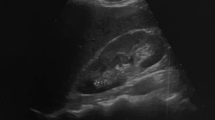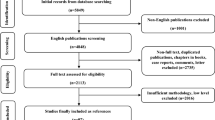Abstract
The first 500 patients who underwent percutaneous stone removal at our hospital and who have been evaluated for at least 8 months were reviewed. Comparison of the first 100 patients with the entire series showed a sharp improvement in the success rate as the radiologic and urologic team gained experience. The success rate for simple pelvicaliceal stones was 98% in the entire series (vs. 89% in the first 100 cases) and 87% for staghorn calculi. The most common complication was bleeding, with 12% of the patients requiring transfusion. Other complications include infection (0.6%), retained stone fragments (4%), and ureteropelvic junction stricture (1%). There was 1 death, an obese diabetic woman who suffered a myocardial infarction. Successful stone extraction requires a properly placed nephrostomy tract, and radiologic and urologic expertise. The advent of extracorporeal shockwave lithotripsy will not abolish the need for nephrostolithotomy.
Similar content being viewed by others
References
Fernstrom I, Johansson B: Percutaneous pyelolithotomy: a new extraction technique.Scand J Urol Nephrol 10:257–259, 1976
Wickham JEA, Kellet NJ: Percutaneous nephrolithotomy.Br Med J 283:1571–1573, 1981
Alken P, Hutschenreiter G, Gunther R, Marberger M: Percutaneous stone manipulation.J Urol 125:463–466, 1981
Narayan P, Smith AD: Percutaneous nephrostomy as an adjunct in the management of ureteral calculi.Urol Clin North Am 9:137–143, 1982
Banner MP, Pollack HM: Percutaneous extraction of renal and ureteral calculi.Radiology 144:753–758, 1982
Wickham JEA, Kellet MJ, Miller RA: Elective percutaneous nephrolithotomy in 50 patients: an analysis of the techniques, results and complications.J Urol 129:904–906, 1983
Segura JW, Patterson DE, LeRoy J, May GR: Percutaneous lithotripsy.J Urol 130:1051–1054, 1983
White EC, Smith AD: Percutaneous stone extraction from 200 patients.J Urol 132:437–438, 1984
Kerlan RK, Kahn RI, Ring EJ: Percutaneous renal and ureteral stone removal.Urol Radiol 6:113–123, 1984
Lee WJ, Loh G, Smith AD, White E, Greenspan B, Vernace FM, Pochaczevsky R: Percutaneous extraction of renal stones: experience in 100 patients.AJR 144:457–462, 1985
Dunnick NR, Carson CC III, Moore AV, Ford K, Miller GA, Braun SD, Newman GE, Weinerth JL: Percutaneous approach to nephrolithiasis.AJR 144:451–455, 1985
Preminger GM, Clayman RV, Hardeman SW, Franklin J, Curry T, Peters PC: Percutaneous nephrostolithotomy vs. open surgery for renal calculi: a comparative study.JAMA 254:1054–1058, 1985
Lange PH, Reddy PK, Hulbert JC, Clayman RV, Castaneda-Zuniga WR, Miller RP, Coleman C, Amplatz K: Percutaneous removal of caliceal and other “inaccessible” stones: instruments and techniques.J Urol 132:439–442, 1984
Reddy PK, Lange PH, Hulbert JC: Percutaneous removal of caliceal and other “inaccessible” stones: results.J Urol 132:443–447, 1984
Smith, AD, Lee WJ: Percutaneous stone removal procedures including irrigation.Urol Clin North Am 10:719–729, 1983
Clayman RV, Hunter D, Surya V, Castaneda-Zuniga WR, Amplatz K, Lange PH: Percutaneous intrarenal electrosurgery.J Urol 131:864–867, 1984
Kaye, KW, Goldberg, ME: Applied anatomy of the kidney and ureter.Urol Clin North Am 9:3–13, 1982
Coleman CC, Castaneda-Zuniga WR, Miller R, Lange P, Clayman R, Reddy P, Hunter DP, Hulbert JC, Salomonowitz E, Lund G, Amplatz K: A logical approach to renal stone removal.AJR 143:609–615, 1984
Coleman CC, Castaneda-Zuniga WR, Kimura Y, Hunter DP, Amplatz K: A systematic approach to puncture-site selection for percutaneous urinary tract stone removal.Semin Intervent Radiol 1:42–49, 1984
Salomonowitz E, Castaneda-Zuniga WR, Lange PH, Cragg AH, Lund G, Hunter DW, Coleman CC, Amplatz K: Percutaneous renal stone removal: use of carbon dioxide as contrast material.Radiology 150:833–834, 1984
Rusnak B, Castaneda-Zuniga WR, Kotula F, Herrera M, Amplatz K: An improved dilator system for percutaneous nephrostomies.Radiology 144:174, 1982
Clayman RV, Castaneda-Zuniga WR, Hunter DW, Miller RP, Lange PH, Amplatz K: Rapid balloon dilatation of nephrostomy tract for nephrostolithotomy.Radiology 147:884–885, 1983
LeRoy AJ, May GR, Segura JW, Patterson DE, McGough PF: Rapid dilatation of percutaneous nephrostomy tracts.AJR 142:355–357, 1984
Smith, AD, Lee, WJ: Techniques and complications of nephrostomy tract dilatation and tube insertion.Br J Urol (suppl) 86–88, 1983
Clayman RV, Castaneda-Zuniga WR (eds):Technique in Endourology: a Guide to the Percutaneous Removal of Renal and Ureteral Calculi. Minneapolis: Endopress, 1984, pp 109–112
Clayman, RV, Surya V, Miller RP, Castaneda-Zuniga WR, Amplatz K, Lange PH: Percutaneous nephrostolithotomy: percutaneous extraction of renal and ureteral calculi from 100 patients.J Urol 131:868–871, 1984
Bush WH, Brannen GE: Percutaneous removal of caliceal calculi.AJR 144:139–142, 1985
Clayman RV, Surya V, Castaneda-Zuniga WR, Miller RP, Lange PH: Percutaneous nephrolithotomy with Mazzaiello-Caprini forceps.J Urol 129:1213–1215, 1983
Sheldon CA, Smith AD: Chemolysis of calculi.Urol Clin North Am 9:121–130, 1982
Gavant ML, Gold RE, Church JC: Delayed rupture of renal pseudoaneurysm: complication of percutaneous nephrostomy.AJR 138:948–949, 1982
Cope C, Zeit RM: Pseudoaneurysms after nephrostomy.AJR 139:255–261, 1982
Clayman RV, Surya V, Hunter D, Castaneda-Zuniga WR, Miller RP, Coleman C, Amplatz K, Lange PH: Renal vascular complications associated with the percutaneous removal of renal calculi.J Urol 132:228–230, 1984
Stables DP: Percutaneous nephrostomy: techniques, indications and results.Urol Clin North Am 9:15–29, 1982
Author information
Authors and Affiliations
Rights and permissions
About this article
Cite this article
Lee, W.J., Smith, A.D., Cubelli, V. et al. Percutaneous nephrolithotomy: Analysis of 500 consecutive cases. Urol Radiol 8, 61–66 (1986). https://doi.org/10.1007/BF02924078
Issue Date:
DOI: https://doi.org/10.1007/BF02924078




